16.1 - 2307 Windsor Rd #2 - photos — original pdf
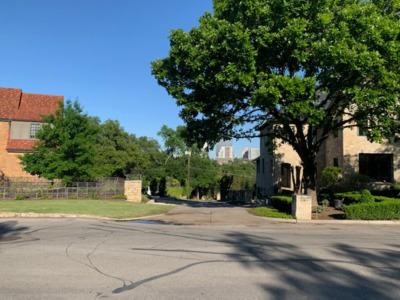
Backup

Backup
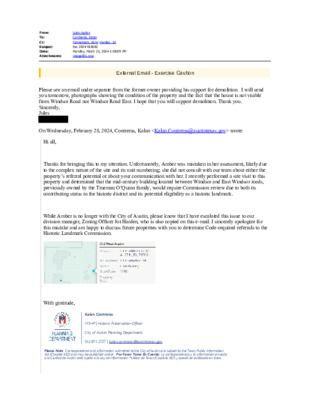
From: To: Cc: Subject: Date: Attachments: jules caplan Contreras, Kalan Fahnestock, Sam; Harden, Joi Re: 2024-018182 Monday, March 25, 2024 5:58:09 PM image001.png External Email - Exercise Caution Please see an email under separate from the former owner providing his support for demolition. I will send you tomorrow, photographs showing the condition of the property and the fact that the house is not visible from Windsor Road nor Windsor Road East. I hope that you will support demolition. Thank you. Sincerely, Jules On Wednesday, February 28, 2024, Contreras, Kalan <Kalan.Contreras@austintexas.gov> wrote: Hi all, Thanks for bringing this to my attention. Unfortunately, Amber was mistaken in her assessment, likely due to the complex nature of the site and its unit numbering; she did not consult with our team about either the property’s referral potential or about your communication with her. I recently performed a site visit to this property and determined that the mid-century building located between Windsor and East Windsor roads, previously owned by the Trueman O’Quinn family, would require Commission review due to both its contributing status in the historic district and its potential eligibility as a historic landmark. While Amber is no longer with the City of Austin, please know that I have escalated this issue to our division manager, Zoning Officer Joi Harden, who is also copied on this e-mail. I sincerely apologize for this mistake and am happy to discuss future properties with you to determine Code-required referrals to the Historic Landmark Commission. With gratitude, Kalan Contreras MSHP | Historic Preservation Officer City of Austin Planning Department 512.974.2727 | kalan.contreras@austintexas.gov Please Note: Correspondence and information submitted to the City of Austin are subject to the Texas Public Information Act (Chapter 552) and may be published online. Por Favor Tome En Cuenta: La correspondencia y la información enviada a la Ciudad de Austin está sujeta a la Ley de Información Pública de Texas (Capítulo 552) y puede ser publicada en línea. Dear Sam, Sincerely, Jules Dear Jules, From: jules caplan Sent: Tuesday, February 27, 2024 6:42 PM To: Fahnestock, Sam <Sam.Fahnestock@austintexas.gov> Cc: Subject: Re: 2024-018182 > ; Allen, Amber <Amber.Allen@austintexas.gov> You don't often get email from . Learn why this is important External Email - Exercise Caution This would be a big problem. Amber Allen in her capacity as Planner III in the Historic Preservation office repeatedly assured me and others in multiple emails that the City …

Backup
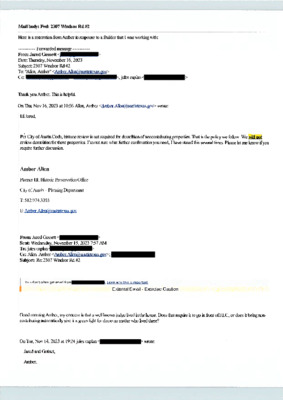
Backup
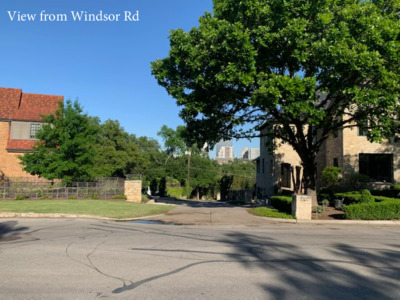
View from Windsor Rd View from Windsor Rd East 4/1/24, 1:51 PM Google Maps Imagery ©2024 Airbus, CAPCOG, CNES / Airbus, Maxar Technologies, U.S. Geological Survey, Map data ©2024 Google 50 ft https://www.google.com/maps/@30.2883395,-97.7552376,245m/data=!3m1!1e3?entry=ttu 1/1 2307 EAST Built in 2000 NON-Contribu�ng 2307 REAR Built in 1950 NON-Contribu�ng 2307 FRONT Built in 1990 NON-Contribu�ng
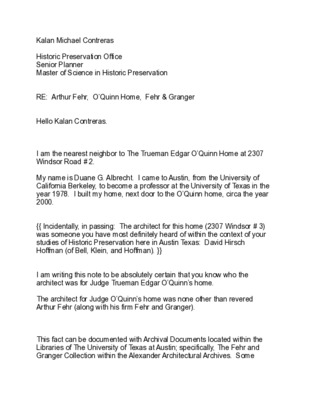
Kalan Michael Contreras Historic Preservation Office Senior Planner Master of Science in Historic Preservation RE: Arthur Fehr, O’Quinn Home, Fehr & Granger Hello Kalan Contreras. I am the nearest neighbor to The Trueman Edgar O’Quinn Home at 2307 Windsor Road # 2. My name is Duane G. Albrecht. I came to Austin, from the University of California Berkeley, to become a professor at the University of Texas in the year 1978. I built my home, next door to the O’Quinn home, circa the year 2000. {{ Incidentally, in passing: The architect for this home (2307 Windsor # 3) was someone you have most definitely heard of within the context of your studies of Historic Preservation here in Austin Texas: David Hirsch Hoffman (of Bell, Klein, and Hoffman). }} I am writing this note to be absolutely certain that you know who the architect was for Judge Trueman Edgar O’Quinn’s home. The architect for Judge O’Quinn’s home was none other than revered Arthur Fehr (along with his firm Fehr and Granger). This fact can be documented with Archival Documents located within the Libraries of The University of Texas at Austin; specifically, The Fehr and Granger Collection within the Alexander Architectural Archives. Some images reflecting these facts are given below. The actual documents can be accessed on-line within the University of Texas Archives. Following this letter, I will send a “PDF” Document. This PDF document contains images that are simply meant to illustrate a very small sample of the many architectural contributions from Arthur Fehr, along with his architectural firm, Fehr and Granger. I do hope these facts will be taken into consideration as the Historic Landmark Commission considers what is best for The Trueman Edgar O’Quinn Home. Thank you so much for your knowledgeable dedication to Historic Preservation within the City of Austin Texas. Duane ———--------——— Duane G. Albrecht Professor University of Texas ———--------——— https://liberalarts.utexas.edu/cps/faculty/dga57 P.S. Please notify me if there has been any problem transmitting the PDF Document illustrating a few examples of the work of Arthur Fehr. I will personally bring a paper copy of the document to your offices.

- - - - - - - - - - -- - - - https://www.jayfarrellarchitect.com/grangerhouse - - - - -
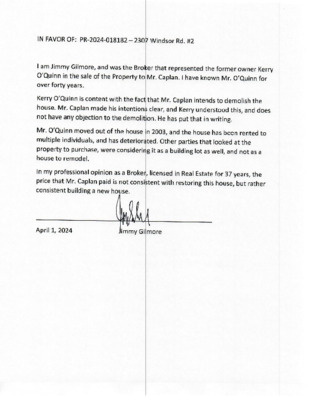
Backup
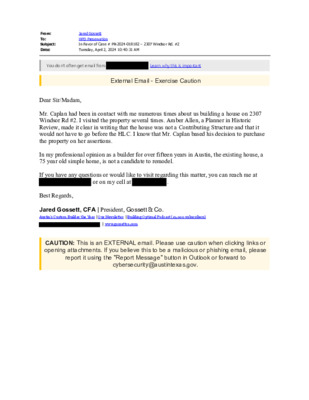
From: To: Subject: Date: Jared Gossett HPD Preservation In Favor of Case # PR-2024-018182 – 2307 Windsor Rd. #2 Tuesday, April 2, 2024 10:40:31 AM You don't often get email from Learn why this is important External Email - Exercise Caution Dear Sir/Madam, Mr. Caplan had been in contact with me numerous times about us building a house on 2307 Windsor Rd #2. I visited the property several times. Amber Allen, a Planner in Historic Review, made it clear in writing that the house was not a Contributing Structure and that it would not have to go before the HLC. I know that Mr. Caplan based his decision to purchase the property on her assertions. In my professional opinion as a builder for over fifteen years in Austin, the existing house, a 75 year old simple home, is not a candidate to remodel. If you have any questions or would like to visit regarding this matter, you can reach me at or on my cell at . Best Regards, Jared Gossett, CFA | President, Gossett & Co. Austin's Custom Builder the Year | Our Newsletter | Building Optimal Podcast (19,000 subscribers) | www.gossettco.com CAUTION: This is an EXTERNAL email. Please use caution when clicking links or opening attachments. If you believe this to be a malicious or phishing email, please report it using the "Report Message" button in Outlook or forward to cybersecurity@austintexas.gov.
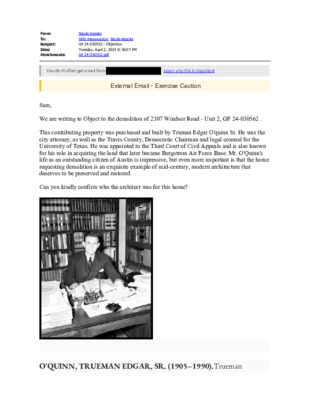
From: To: Subject: Date: Attachments: Nicole Kessler HPD Preservation; Nicole Kessler GF 24-030562 - Objection Tuesday, April 2, 2024 8:38:07 PM GF 24-030562.pdf You don't often get email from . Learn why this is important External Email - Exercise Caution Sam, We are writing to Object to the demolition of 2307 Windsor Road - Unit 2, GF 24-030562 . This contributing property was purchased and built by Truman Edgar O'quinn Sr. He was the city attorney, as well as the Travis County, Democratic Chairman and legal counsel for the University of Texas. He was appointed to the Third Court of Civil Appeals and is also known for his role in acquiring the land that later became Bergstrom Air Force Base. Mr. O'Quinn's life as an outstanding citizen of Austin is impressive, but even more important is that the home requesting demolition is an exquisite example of mid-century, modern architecture that deserves to be preserved and restored. Can you kindly confirm who the architect was for this home? O'QUINN, TRUEMAN EDGAR, SR. (1905–1990).Trueman O'Quinn, attorney, judge, and historian, was born in Leesville, Louisiana, on May 7, 1905, to Dallas Patrick and Florence Isabelle (O'Connor) O'Quinn. He was one of three children. In 1917 the family left Vernon Parish and moved to East Texas. As a child, O'Quinn was active in Boy Scouts and eventually became an Eagle Scout. He graduated from Beaumont High School in 1922 and enrolled at the University of Texas that same year. O'Quinn supported himself through college by teaching fencing and writing syndicated news stories. He also served as editor of the Daily Texan, 1927–1928. After completing his bachelor's degree, O'Quinn studied law and passed the bar in 1932. He remained in Austin, where he opened a private practice. O'Quinn's interest in law led him to politics. He was elected to the Forty- Second Texas Legislature and served the 1931–1932 term as a representative for Jefferson County. In 1936, O'Quinn was appointed assistant city attorney of Austin, and by 1939 was city attorney. With the exception of the years he served during World War II, he held the position until 1950. During the war, O'Quinn served in various capacities. He was a lt. colonel in the 101st Airborne Division and fought in four major battles. As Staff Judge Advocate, he supervised court-martial trials in Normandy after the Allied invasion. He also served with the army of occupation …
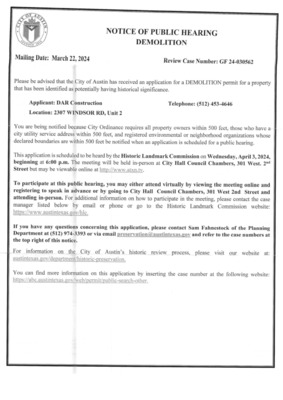
Nicole Kessler 2309 Windsor Road 78703 April 2, 2024 This contributing property was purchased and built by Truman Edgar O'quinn Sr. He was the city attorney, as well as Travis county, Democratic Chairman and legal counsel for the University of Texas. He was appointed to the Third Court of Civil Appeals. He acquired the land that later became Bergstrom Air Force Base. The home is an exquisite example of mid century, modern architecture that deserves to be preserved and restored.
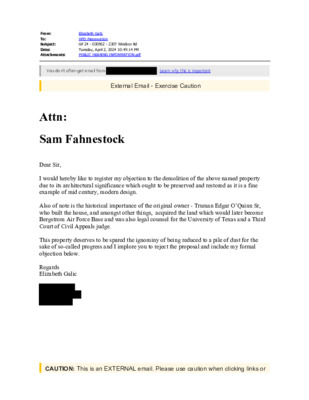
From: To: Subject: Date: Attachments: Elizabeth Galic HPD Preservation GF 24 - 030562 - 2307 Windsor Rd Tuesday, April 2, 2024 10:49:14 PM PUBLIC HEARING INFORMATION.pdf You don't often get email from . Learn why this is important External Email - Exercise Caution Attn: Dear Sir, Sam Fahnestock I would hereby like to register my objection to the demolition of the above named property due to its architectural significance which ought to be preserved and restored as it is a fine example of mid century, modern design. Also of note is the historical importance of the original owner - Truman Edgar O’Quinn Sr, who built the house, and amongst other things, acquired the land which would later become Bergstrom Air Force Base and was also legal counsel for the University of Texas and a Third Court of Civil Appeals judge. This property deserves to be spared the ignominy of being reduced to a pile of dust for the sake of so-called progress and I implore you to reject the proposal and include my formal objection below. Regards Elizabeth Galic CAUTION: This is an EXTERNAL email. Please use caution when clicking links or opening attachments. If you believe this to be a malicious or phishing email, please report it using the "Report Message" button in Outlook or forward to cybersecurity@austintexas.gov. Sent from my iPhone

From: To: Subject: Date: Contreras, Kalan Fahnestock, Sam FW: Demolition of 2307 Windsor rd Wednesday, April 3, 2024 11:09:41 AM Please post as late backup. Thank you! Kalan Contreras MSHP | she/her | Historic Preservation Officer City of Austin Planning Department 512.974.2727 | kalan.contreras@austintexas.gov Please Note: Correspondence and information submitted to the City of Austin are subject to the Texas Public Information Act (Chapter 552) and may be published online. Por Favor Tome En Cuenta: La correspondencia y la información enviada a la Ciudad de Austin está sujeta a la Ley de Información Pública de Texas (Capítulo 552) y puede ser publicada en línea. -----Original Message----- From: Evy Burnett < Sent: Wednesday, April 3, 2024 11:05 AM To: Contreras, Kalan <Kalan.Contreras@austintexas.gov>; Harden, Joi <Joi.Harden@austintexas.gov> Subject: Demolition of 2307 Windsor rd > [Some people who received this message don't often get email from important at https://aka.ms/LearnAboutSenderIdentification ] . Learn why this is External Email - Exercise Caution Dear Kalan I’m writing to you today to respectfully ask that you please delay the decision/ demolition of 2307 # 2 Windsor Rd. I live at 2307 Windsor Rd, Austin TX #1 and share a drive way with the property considered for demolition. Thank you for your consideration Regards Evy Burnett CAUTION: This is an EXTERNAL email. Please use caution when clicking links or opening attachments. If you believe this to be a malicious or phishing email, please report it using the "Report Message" button in Outlook or forward to cybersecurity@austintexas.gov.
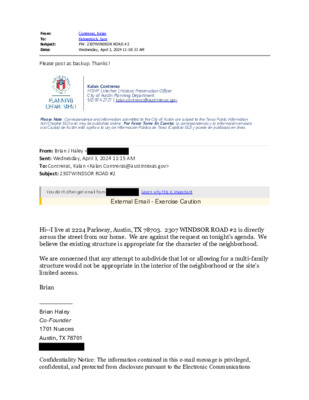
From: To: Subject: Date: Contreras, Kalan Fahnestock, Sam FW: 2307WINDSOR ROAD #2 Wednesday, April 3, 2024 11:18:33 AM Please post as backup. Thanks! Kalan Contreras MSHP | she/her | Historic Preservation Officer City of Austin Planning Department 512.974.2727 | kalan.contreras@austintexas.gov Please Note: Correspondence and information submitted to the City of Austin are subject to the Texas Public Information Act (Chapter 552) and may be published online. Por Favor Tome En Cuenta: La correspondencia y la información enviada a la Ciudad de Austin está sujeta a la Ley de Información Pública de Texas (Capítulo 552) y puede ser publicada en línea. From: Brian J Haley < Sent: Wednesday, April 3, 2024 11:15 AM To: Contreras, Kalan <Kalan.Contreras@austintexas.gov> Subject: 2307WINDSOR ROAD #2 You don't often get email from . Learn why this is important External Email - Exercise Caution Hi--I live at 2224 Parkway, Austin, TX 78703. 2307 WINDSOR ROAD #2 is directly across the street from our home. We are against the request on tonight's agenda. We believe the existing structure is appropriate for the character of the neighborhood. We are concerned that any attempt to subdivide that lot or allowing for a multi-family structure would not be appropriate in the interior of the neighborhood or the site's limited access. Brian —————— Brian Haley Co-Founder 1701 Nueces Austin, TX 78701 Confidentiality Notice: The information contained in this e-mail message is privileged, confidential, and protected from disclosure pursuant to the Electronic Communications Privacy Act, 18 U.S.C. sec. 2510-2521. If you are not the intended recipient, any dissemination, distribution, or copying is strictly prohibited. If you think you have received this e-mail message in error, please e-mail the sender at original e-mail transmission. Thank you. and destroy the CAUTION: This is an EXTERNAL email. Please use caution when clicking links or opening attachments. If you believe this to be a malicious or phishing email, please report it using the "Report Message" button in Outlook or forward to cybersecurity@austintexas.gov.
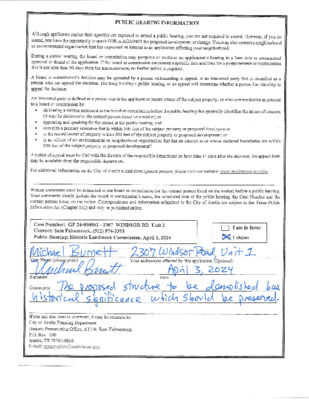
Backup
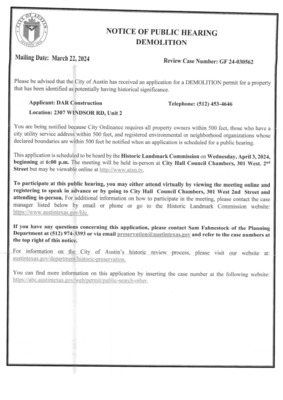
Brian Haley2224 Parkway, Austin, TX 7870304/03/04My house is across the street from the subject property. I object to this case and believemore involvement from the neighbors should be sought.
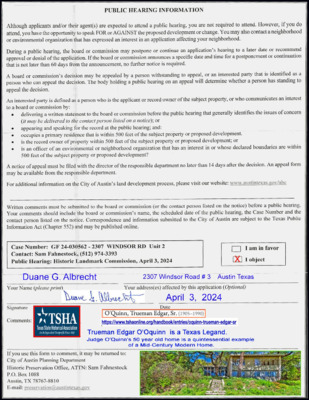
Backup
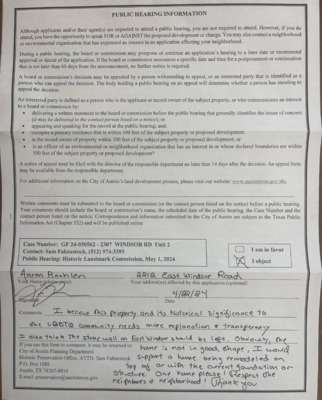
Backup
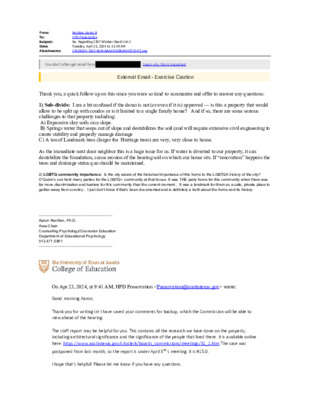
From: To: Subject: Date: Attachments: Rochlen, Aaron B HPD Preservation Re: Regarding 2307 Windsor Road Unit 2 Tuesday, April 23, 2024 11:11:59 AM 2342BD21-7162-46FA-BAA4-042861814ECD[47].png You don't often get email from . Learn why this is important External Email - Exercise Caution Thank you, a quick follow up on this since you were so kind to summarize and offer to answer any questions: 1) Sub-divide: I am a bit confused if the demo is not (or even if it is) approved — is this a property that would allow to be split up with condos or is it limited to a single family home? And if so, there are some serious challenges to that property including: A) Expansive clay soils on a slope. B) Springs water that seeps out of slope and destabilizes the soil (and will require extensive civil engineering to create stability and properly manage drainage C) A ton of Landmark tress (larger the Heritage trees) are very, very close to house. As the immediate next door neighbor this is a huge issue for us. If water is diverted to our property, it can destabilize the foundation, cause erosion of the bearing soil on which our home sits. If “renovation” happens the trees and drainage status quo should be maintained. 2) LGBTQ community importance: Is the city aware of the historical importance of this home to the LGBTQA history of the city? O’Quinn’s son held many parties for the LGBTQ+ community at that house. It was THE party home for this community when there was far more discrimination and barriers for this community than the current moment.. It was a landmark for them as a safe, private place to gather away from scrutiny.. I just don’t know if that’s been documented and is definitely a truth about the home and its history. --------------------------------------------------------- Aaron Rochlen, Ph.D. Area Chair Counseling Psychology/Counselor Education Department of Educational Psychology 512.471.0361 --------------------------------------------------------- On Apr 23, 2024, at 9:41 AM, HPD Preservation <Preservation@austintexas.gov> wrote: Good morning Aaron, Thank you for writing in! I have saved your comments for backup, which the Commission will be able to view ahead of the hearing. The staff report may be helpful for you. This contains all the research we have done on the property, including architectural significance and the significance of the people that lived there. It is available online here: https://www.austintexas.gov/cityclerk/boards_commissions/meetings/31_1.htm The case was postponed from last month, …

Backup